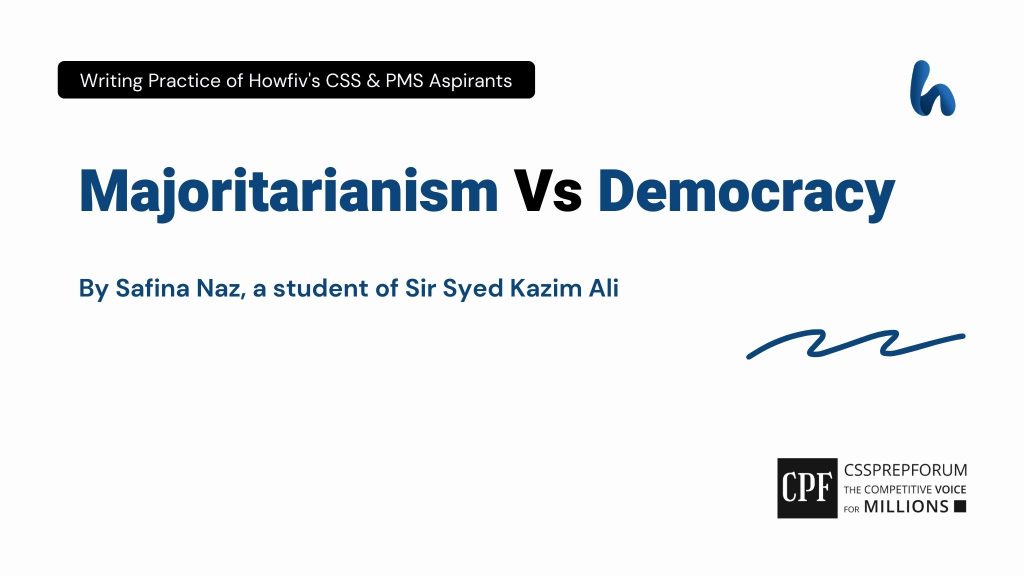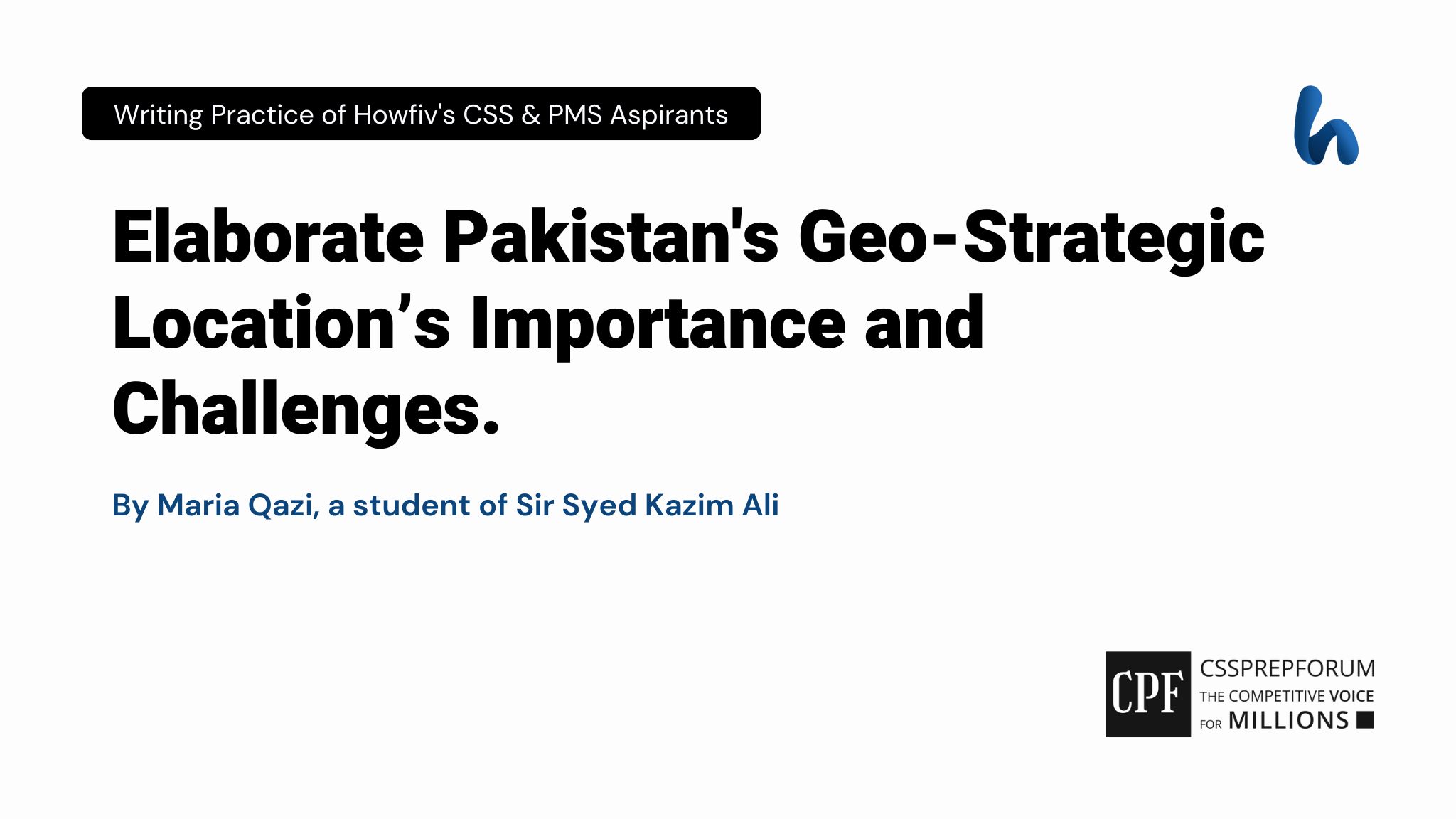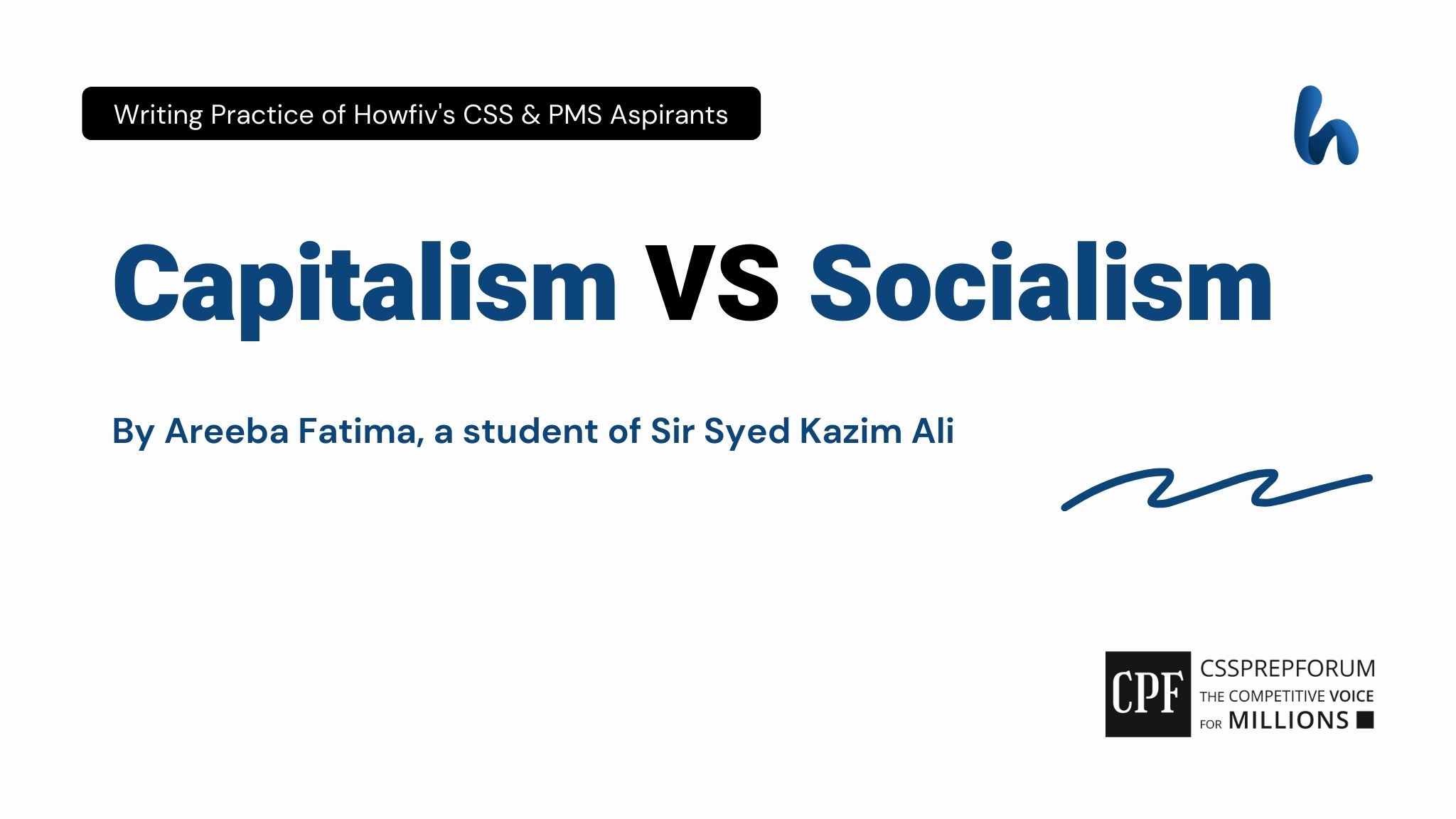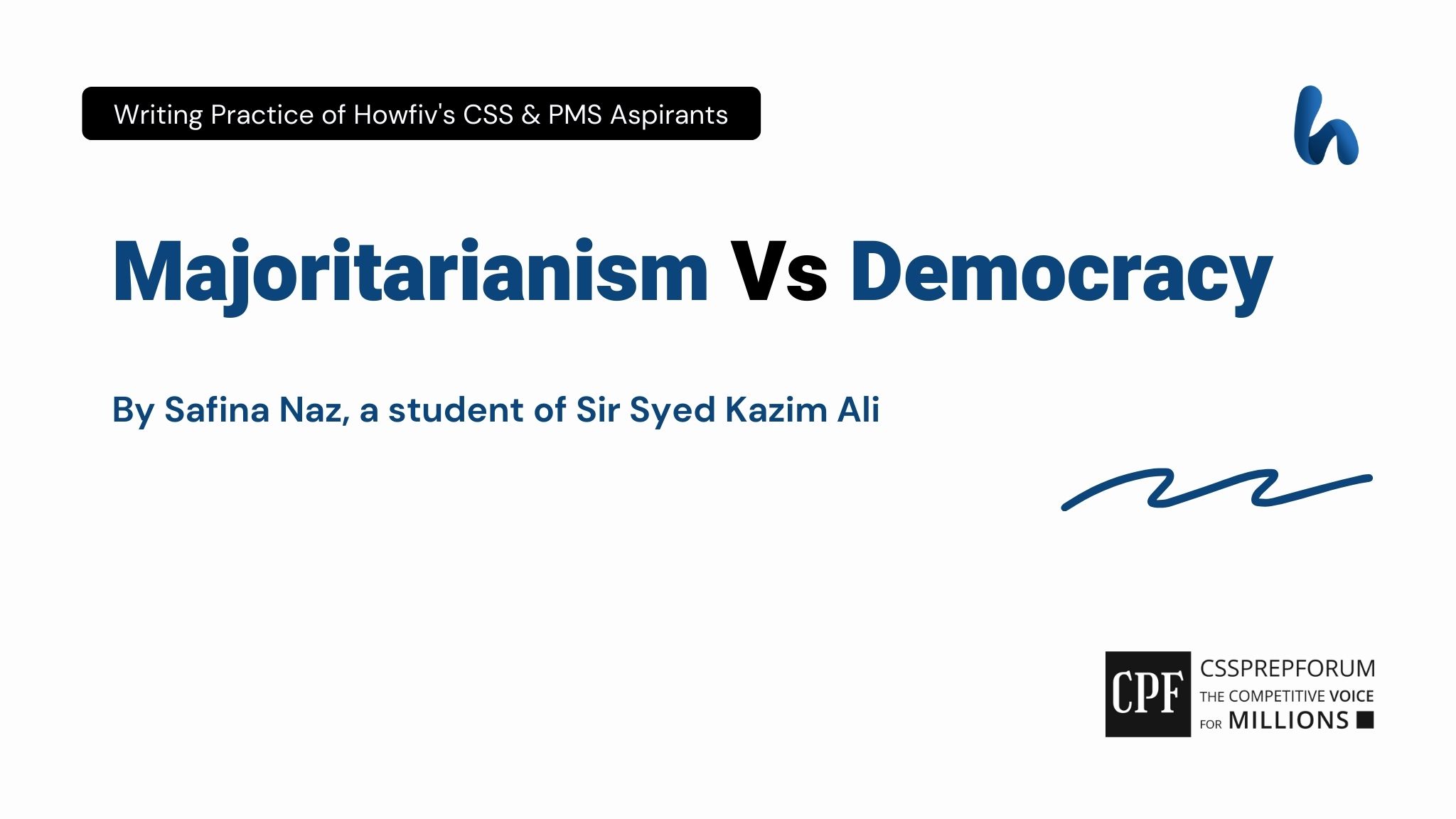Majoritarianism Vs Democracy | Daily Writeup | Opinions
The following article, “Majoritarianism Vs Democracy“, is written by Safina Naz, a student of Sir Syed Kazim Ali. Moreover, the article is written on the same pattern, taught by Sir to his students, scoring the highest marks in compulsory subjects for years. Sir Kazim has uploaded his students’ solved past paper questions so other thousands of aspirants can understand how to crack a topic or question, how to write relevantly, what coherence is, and how to include and connect ideas, opinions, and suggestions to score the maximum.

Outline
1-Introduction
2-Conceptualizing democracy
3-Tracing the historical development of democracy and majoritarianism
4-What are the prominent similarities between majoritarianism and democracy?
- ✓The government of the majority
- Case in point: Mentioning the data of the Ministry of Foreign Affairs of Denmark, Denmark constitutes a majority government consisting of the Social Democrats, the Liberals, and the Moderates.
- ✓Selection of political representatives through elections
- Case in point: According to the Pew Research Center, 66% of the United States’ adult citizens participated in the 2020 presidential elections.
- ✓Belief in popular sovereignty
- Case in point: According to an article in Chatham House, 70 million South Koreans gathered in large numbers to exercise their right of popular sovereignty against President Park Geun-hye’s corruption.
- ✓Public participation in the formation of government
- Case in point: According to a report of the Abo Akademie University of Finland, the voter turnout in Finland for the 2023 elections was 72%, showing an abundant number of people who utilized their right to political participation.
5-How is majoritarianism different from democracy?
- ✓Creating a majority and minority debate
- Case in point: According to an article by Carnegie Endowment for International Peace, the elections of 2014 and 2019 have deprived minority groups, predominantly Muslim, of their due right to be a part of the political system in India, leading to zero seats for Muslim out of 303 seats in Lok Sabah.
- ✓Promoting political polarization
- Case in point: Turkey that has faced the consequences of political polarization, rising from the majoritarian regime in the country.
- ✓Involving only a selected section in decision-making
- Case in point: According to the Geneva Graduate Institute, Hungarian Prime Minister Victor Orban, under the pretext of majoritarian government, has promoted majoritarianism by enacting some 700 laws that were entirely against liberal democracy.
- ✓Promoting the tyranny of the majority
- Case in point: To Yale Review of International Studies, the majoritarian government of the Sinhalese Buddhist group has institutionalized and legitimatized the discrimination of minorities, giving rise to the tyranny of the majority.
- ✓Weakening system of checks and balances
- Case in point: According to the Indian Forum Journal, the Union Law Ministers of the Modi-led government, a majoritarian government, were part of the efforts to discredit the judiciary and accept the primacy of the central government in appointing judges and influencing the judiciary’s functions.
6-Critical Analysis
7-Conclusion

Democracy, a form of government, is the cornerstone of the country’s social, political, and economic development. Indeed, it is based on specific values, attitudes, and practices that work in liaison with each other, leading to the efficient working of a democratic country. In its true essence, democracy is the government of the people, by the people, and for the people, where every individual has equal rights, freedom, and opportunities. However, the doctrine of majoritarianism, often confused with democracy, is solely the rule of the majority over all the classes of a country. Therefore, it is sufficient to say that democracy and majoritarianism are two divergent ideologies. A prominent example of a country where majoritarianism exists is India. According to the Journal of Legal Service India, majoritarianism prevails in India in political and social spheres, undermining the minority communities in the country. Moreover, both democracy and majoritarianism differ from each other as the latter involves a selected proportion in decision-making and promotes the tyranny of the majority. Further, political polarization rises to its peak under majority rule, again antithetical to democratic principles. Hence, democracy in all its forms is different from majoritarianism, which thrives by curtailing the rights of minorities, be it ethnic, linguistic, or religious. Nonetheless, democracy and majoritarianism share some common grounds in representation through election and political participation. Further, in both ideologies, popular sovereignty vests in people and political leaders are held accountable to the people. This article briefly describes majoritarianism and democracy and brings to light the similarities and differences between majoritarianism and democracy.
Starting with unearthing the concept of democracy as described by the World Bank is the active functioning of institutions and procedures through which citizens can express effective preferences about alternative policies and leaders. Supporting the idea of popular sovereignty and collective decision-making are the core values of democracy. In addition, certain fundamental principles of democracy, such as respect for basic human rights, including the right to speech, a multi-party-political system where every individual has a right to have a political party, a democratic voting system which provides equal voting opportunity to all citizens, and respect for the rule of law, make it stand out from the other forms of government. Though a rule of majority, protecting the rights of minorities, and providing equal opportunities to all state citizens are among the cardinal features of democracy. Thus, democracy, in its elected or representative form, thrives on the idea of collectiveness and provides freedom to all citizens.
Heading towards the jargon of majoritarianism, it is a form of government in which the majority rules over the minority, exercises power, and dominates society. The philosophical thought behind majoritarianism is the rule of the majority in an area based on religion, language, ethnicity, and social class. The dragon of majoritarianism flourishes by curtailing the rights and freedom of minority groups in a state. Further, it provides superiority and primacy to a particular group of people over others, thereby dividing the groups on social, economic, and political fronts. Hence, it involves the majority population in the decision-making process and deprives all the minorities of doing so.
Turning over the papers of history, the genesis of democracy can be traced back to the times of Greece and Athens, wherein democracy emerged with the establishment of a city-state by Athens, which deviated from the autocratic practices of earlier times. In Athens, individuals were given the right to participate in the electoral process, governmental positions, and legal proceedings, fulfilling the essence of democracy. Similarly, democracy can be traced back to ancient civilizations, including the Romans, Greeks, and Persians. However, during the early years of democracy, women were excluded from the democratic system. On the contrary, modern democracy involves all individuals, either male or female, and it emerged during the time of the French Revolution and the American Revolution. Stepping into the 20th and 21st centuries, democracy exponentially expanded its ambit and broadened its scope by providing equal rights to state the city, including women previously excluded. The fundamental objective of democracy that has evolved over time is majority rule while considering all the classes of society. On the other hand, the emergence of majoritarianism can be dated back to the American Revolution and French Revolution. The concept of majoritarianism has gradually evolved from a democratic system to the point that it has changed into tyranny, leading to administrative despotism. With the broadening of the democratic sphere, which is the rule of the majority, around the globe, majoritarian philosophy has also been institutionalized and politicized. Subsequently, majoritarianism has developed in the political system along with the development of democracy. However, the scope of functionalities that democratic and majoritarian countries manifest is entirely different.
Diving deep into the matter by shedding light on similarities, there are some commonalities that democracy and majoritarianism share. Talking about them, both democracy and majoritarianism form governments based on the majority. The political parties have the majority seats, and the majority vote bank is the ruling party. According to the data of the Ministry of Foreign Affairs of Denmark, Denmark constitutes a majority government consisting of the Social Democrats, the Liberals, and the Moderates. The coalition government formed by these three make up the government of Denmark. Similarly, Majoritarianism, as in India, is the government of the majority. For example, India currently has a majoritarian government consisting of the Bhartithe ya Janta Party BJP as the state’s ruling party. Thus, both the latter and the former form governments based on the majority.
In addition, political representatives in a democratic and a majoritarian country are elected through elections. Political party securing majority votes is considered victorious, and power vests in their hands. Taking evidence from the Pew Research Center, the presidential elections of the United States of America in 2020 involved 66% of U.S. adult citizens. The data clearly depicts that the government, headed by Joe Biden, was truly democratic as state citizens participated in elections and elected Joe Biden as their President through the Electoral College. Correspondingly, the government formed through majoritarianism is elected through elections. For instance, the Russian government, which is considered majoritarian, is elected through elections where people elect their President, Vladimir Putin. Vladimir Putin, perceived as a majoritarian leader, has come to power in the last three consecutive elections. Thus, majoritarianism and democracy share common grounds based on electing the representatives.
Besides, democracy and majoritarianism are the proponents of popular sovereignty. In both, the will of the people is considered sovereign, and ultimate power vests in the people as they elect representatives who eventually hold control of the state. The State officials are accountable to the people. According to an article in Chatham House, South Korean people exercised their right of popular sovereignty by gathering in a large number, 70 million South Koreans, against the corruption of President Park Geun-hye. The report manifests that by using their democratic rights, state citizens held their leaders accountable, supporting the idea that popular sovereignty vests in people in a democratic country. Likewise, in countries with the ideology of majoritarianism, people are sovereign, and state officials are accountable to them. For instance, Turkey, a majoritarian country, holds the leaders responsible as the political leaders are elected by the people’s will. To sum up, popular sovereignty is the common ground shared by a majoritarian and a democratic country.
Additionally, democracy and majoritarianism involve political participation. Every state citizen has the right to vote according to his will, support or join a political party, and run a political campaign. The democratic system of Finland, an entire democratic country, is a case in point. According to a report from Abo Akademie University of Finland, the voter turnout in Finland for the 2023 elections was 72%, showing an abundant number of people who utilized their right to political participation. The data shows significant political participation of the citizens that ultimately formed the government in the country. Similar is the case with majoritarian countries. In the 2022 election, the majority of the population voted for Benjamin Netanyahu, leading to the formation of a majoritarian government of Netanyahu in Israel. Hence, political participation is imperative for democracy and majoritarianism.
To go further in the depth of the matter, majoritarianism and democracy are two different ideologies, containing stark differences in their functions. The first and foremost one is that a majoritarian country creates a divide among state citizens by dividing them on religious, ethnic, or linguistic grounds and providing a breeding ground for majority vs minority debate. Consequently, dichotomy based on different grounds leads to the marginalization of one group and domination of another. Taking an example, according to an article from Carnegie Endowment for International Peace, the elections of 2014 and 2019 have deprived minority groups, predominantly Muslims, of their due right to be a part of the political system in India, leading to zero seats for Muslim out of 303 seats in Lok Sabah. This clearly manifests that a majoritarian government has deprived the state citizens of their right to equal participation. On the flip side, democracy safeguards the rights of all citizens, either majority or minority. Thus, a significant difference between democracy and majoritarianism is the protection of citizen rights.
Second, producing echo chambers and creating a highly polarized society is the feature of a majoritarian country. The country with majoritarian politics faces a downward democratic trajectory as polarization and democracy are poles apart. An example is Turkey, which has faced the consequences of political polarization, rising from the country’s majoritarian regime. Majoritarianism has polarized the democratic institutions, consequently eroding the public interest in state institutions as, in a majoritarian country, the decision is made to attract a majority, a deprived chunk of the state, and other members are kept deprived. Conversely, a democratic country holds public interest as their top-notch priority and creates a society that flourishes on shared social and cultural values. Hence, it is a gospel truth that majoritarianism and democracy are entirely different ideologies with different agendas.
Third, in a majoritarian country, decision-making power vests in the representatives of the majoritarian government. The biased policies and decisions of majoritarian leaders lead to reduced institutional transparency. According to the Geneva Graduate Institute, under the pretext of a majoritarian government, Hungarian Prime Minister Victor Orban promoted majoritarianism in the country by enacting some 700 laws that were entirely against liberal democracy. Majoritarian Prime Minister has strengthened authoritarianism under the banner of majority rule by passing ad hoc policies such as changing the electoral framework, making it impossible for another party to win, and altering the system for appointing judges to constitutional courts. Conversely, democracy believes in the independent decision-making of state institutions, be it the executive, legislative, or judiciary. Moreover, providing an opportunity to all the elected members of the government, either belonging to the victory party or loser, is the mantra of democracy. Hence, democracy and majoritarianism orient states differently based on their functionalities.
Moreover, creating the tyranny of the majority and undermining the minorities are practical forms of majoritarianism. The majoritarian government tries to maintain its hegemony in the state by passing laws solely aimed at suppressing minorities. The example of Sri Lanka is no different. According to the Yale Review of International Studies, the majoritarian government of the Sinhalese Buddhist group has institutionalized and legitimatized the discrimination of minorities, giving rise to the tyranny of the majority. Sinhalese group has time and again curtailed the rights of Tamil, a minority group, in Sri Lanka. Eventually, the second-largest minority of the country feels alienated. On the flip side, a democratic country believes in ethnic, lingual, and religious harmony, giving all the members of the state equal opportunity. It grows extravagantly by the coordination among different state groups. Therefore, a country claiming to be a majoritarian country differs entirely from a democratic one.
Further, majoritarianism weakens checks and balances in the state system. This system is designed to maintain the balance of power between institutions, thereby overcoming the tyranny of the majority. Majoritarian leaders intervene in the powers of different institutions and take control into their hands, maintaining their hegemony over the state. According to the Indian Forum Journal, Union Law Ministers of the Modi-led government, a majoritarian government, were part of the efforts to discredit the judiciary and accept the primacy of the central government in appointing judges and influencing functions of the judiciary. The central government, thus, tried to come out of its ambit and interfered with the functions of state institutions and the judiciary. This was possible due to weak checks and balances in the system. Contrarily, a democratic country has solid checks and balances that keep a balance of power among state institutions, judiciary, executive, and legislature. In the USA, a moderate balance of power is maintained due to the adequate checks and balances that one state institution imposes on the other. Hence, a majoritarian philosophy is different from a democratic one.
Under the critical lens, democracy in all its forms is better than majoritarianism. Both majoritarianism and democracy are two different ideologies having multiple contrasting features. Majoritarianism, with its main features, is antithetical to democracy based on its ideology of ruling by the majority over the state. It undermines the rights of minorities and rules over the country, giving rise to authoritarianism in the country. Turkey is a prominent example of a country where majoritarianism has flourished to its full potential under the leadership of Tayyip Erdogan. Comparing majoritarianism and democracy on practical grounds, democracy seems to be a peaceful form of governing the masses as it forms the government of the people, by the people, and for the people. Further, keeping up with its true essence, democracy protects the rights of all the state citizens, ethnic groups, and religious entities in a country.
Therefore, in an analysis, a democratic country stands out in the community of nations compared to a majoritarian one as democracy ensures rights, freedom, and the rule of law.
Towards the crux, democracy is the form of government where the government rules according to the people’s will, ensuring equal rights and freedom to all state citizens. Majoritarianism, often confused with democracy, though it shares some similarities with democracy, is the form of government where the majority rules the country. Democracy and majoritarianism share some common grounds, including the formation of government by the majority and the involvement of people in the formation of government. However, there are stark differences between their work and agendas. Mentioning majoritarianism, exercising hegemony all over the country and operating by curtailing the rights of minorities are norms of majoritarianism. Moreover, it weakens the system of checks and balances. Democracy, on the contrary, imposes checks and balances on state institutions for the effective functioning of state machinery. Hence, there is a significant difference between the two ideologies. The debate makes it clear, in the contemporary era that the preferable system for a country to adopt is none but a democratic one as it is more effective than the majoritarian system.

CSS Solved Past Papers’ Essays
Looking for the last ten years of CSS and PMS Solved Essays and want to know how Sir Kazim’s students write and score the highest marks in the essays’ papers? Then, click on the CSS Solved Essays to start reading them.
CSS Solved Essays
CSS Solved General Science & Ability Past Papers
Want to read the last ten years’ General Science & Ability Solved Past Papers to learn how to attempt them and to score high? Let’s click on the link below to read them all freely. All past papers have been solved by Miss Iqra Ali & Dr Nishat Baloch, Pakistan’s top CSS GSA coach having the highest score of their students. General Science & Ability Solved Past Papers












